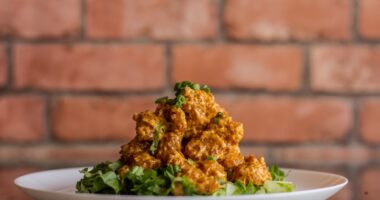
Unfortunately, these grains and their derivatives can be found in what seems like everything, so it can be helpful to know exactly what foods to avoid. The good news is there are many gluten-free alternatives to the favorites on this list. According to the Celiac Disease Foundation, these are gluten heavy hitters:
- Breads, such as loaves, bagels, pita, and flour tortillas
- Pastries, such as croissants, muffins, and donuts
- Pasta, such as spaghetti, ravioli, and gnocchi
- Noodles, such as egg noodles, ramen, and chow mein
- Baked goods, such as cookies, cakes, and pies
- Breakfast foods, such as cereals, granola, and pancakes
- Snacks, such as candy bars, crackers, and pretzels
- Condiments, such as dressings, sauces, and gravy
Even foods that don’t naturally contain gluten, such as oats, can be risky if they’ve potentially been cross-contaminated. “Regular oats are highly contaminated with gluten from growing and processing, so one can only consume oats that are labeled gluten-free,” says Smith.
What naturally gluten-free foods can you eat on a celiac disease diet?
At first glance, a celiac disease diet can seem really restrictive (Really, no bread?!), but you might be surprised to learn just how many foods are naturally gluten-free. In fact, the Celiac Disease Foundation points out that people with celiac disease can still enjoy plenty of eats.
While the main action item on this diet is to avoid gluten, it’s still equally important to eat a diverse range of foods to get all your essential nutrients, says Dr. Jossen. Let’s dive into what that might look like with these four naturally gluten-free food groups.
Fruits and vegetables
READ RELATED: Please, Please Don’t Drink Your Pee to ‘Cure’ COVID
In general, the U.S. Dietary Guidelines for Americans recommend eating at least 2.5 cups of vegetables and 2 cups of fruit per day.2 Here’s the even better part: Not only are fruits and vegetables naturally gluten-free, but they are chock-full of important nutrients, so feel free to fill your plate with as many as possible. Throw some broccoli into your egg scramble, mix some cauliflower rice into your taco bowl, or roast some Brussels sprouts to have with your dinner for a little veggie boost.
Meat, poultry, and seafood
When it comes to protein choices, meat, poultry, and seafood are all naturally gluten-free. These animal products are great sources of essential nutrients, especially protein and B vitamins. That being said, if you’re gluten-free and also vegetarian or vegan, you’ll want to fill your protein needs from plant-based sources like beans, tofu, legumes, nuts, and seeds instead.
Milk, eggs, and dairy
According to an older study published in the journal Digestion, lactose intolerance is often associated with celiac disease.3 However, not everyone with celiac disease is lactose intolerant, and milk, yogurt, and cheese are great sources of B vitamins, vitamin D, and calcium—especially if you’re on a gluten-free diet. If you can’t tolerate milk and dairy, still consider the humble egg. Not only are eggs naturally gluten-free, but they are a great source of protein.
Legumes, beans, nuts, and seeds
Even if you’re not vegetarian or vegan, diversifying where you get your starches from can help boost the nutrition of your meals. You may be surprised by how many gluten-free starches are out there, too. Choose gluten-free products made from a variety of grains when you can, this includes not just rice and corn but also quinoa, buckwheat, amaranth, and teff, Dr. Jossen says. Let’s not forget legumes, like black beans, chickpeas, and peas, all varieties of potatoes, and nutrient-rich nuts and seeds, either.
Source: SELF








